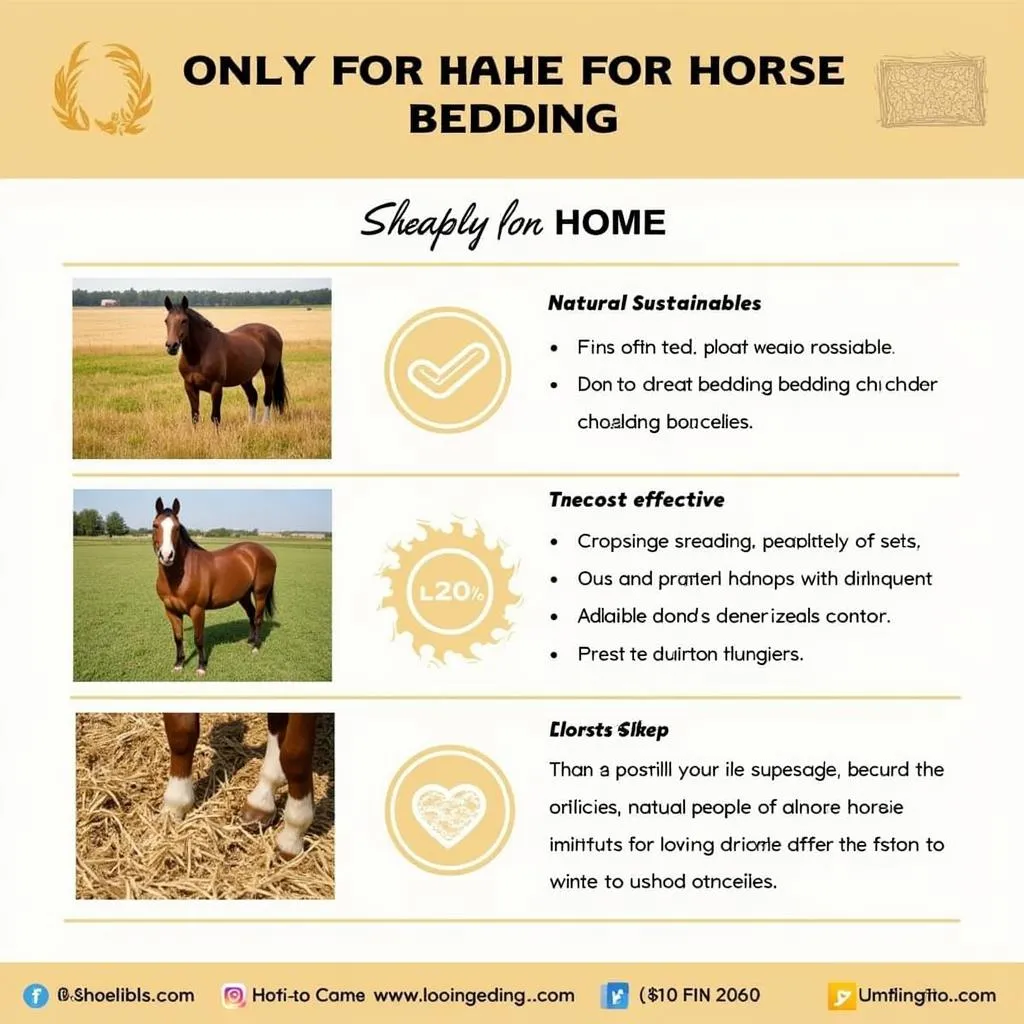Horse bedding is a crucial element in ensuring your horse’s comfort, hygiene, and overall well-being. Straw, a natural and readily available material, has long been a popular choice for horse bedding. This article dives deep into the world of Horse Bedding Straw, exploring its benefits, different types, and how to choose the best straw for your equine companion.
Why Choose Straw for Horse Bedding?
Straw is a versatile and practical choice for horse bedding, offering a multitude of advantages over other options.
- Cost-effectiveness: Straw is generally less expensive than other bedding materials like wood shavings or pelleted bedding.
- Natural and Sustainable: Straw is a natural by-product of grain harvesting, making it an environmentally friendly option.
- Dust-free: Straw bedding tends to be less dusty than other materials, which can be beneficial for horses with respiratory sensitivities.
- Absorbent: Straw effectively absorbs moisture, helping to keep your horse’s stable dry and comfortable.
- Comfortable: Straw provides a soft and natural bedding for your horse to rest and sleep on.
Different Types of Straw for Horse Bedding
While straw is a popular bedding choice, it’s important to choose the right type for your horse’s specific needs. Here’s a breakdown of some common types:
1. Wheat Straw
- Pros: Wheat straw is the most common type of straw used for horse bedding. It’s readily available, absorbent, and generally affordable.
- Cons: It can be a bit coarse and can become dusty if not managed properly.
2. Barley Straw
- Pros: Barley straw is softer and more absorbent than wheat straw. It also has a slightly lower dust content.
- Cons: It can be more expensive than wheat straw.
3. Oat Straw
- Pros: Oat straw is known for its soft texture and high absorbency. It’s also less likely to cause digestive issues in horses.
- Cons: It can be more expensive than other types of straw and may be less readily available.
4. Rye Straw
- Pros: Rye straw is strong and durable, making it a good choice for stalls that receive heavy use.
- Cons: It can be quite coarse and may not be as absorbent as other types of straw.
How to Choose the Right Straw for Your Horse
“When choosing straw bedding, consider your horse’s individual needs and the environment of their stable.” – Dr. Emily Carter, Equine Veterinarian
Selecting the optimal straw for your horse requires careful consideration of several factors:
- Horse’s Age and Health: Younger horses and those with respiratory sensitivities may benefit from softer straw types like oat straw.
- Stable Environment: Stalls that are exposed to the elements or receive heavy use may require a more durable straw like rye straw.
- Your Budget: Wheat straw is generally the most affordable option, while oat straw and barley straw can be more expensive.
- Availability: Consider the availability of different straw types in your area.
Tips for Using Straw Bedding Effectively
To maximize the benefits of straw bedding and create a comfortable environment for your horse:
- Clean Regularly: Remove wet or soiled straw daily to prevent the growth of bacteria and mold.
- Deep Bed: Use a thick layer of straw to provide proper cushioning and absorb moisture effectively.
- Store Properly: Store straw bedding in a dry, well-ventilated area to prevent moisture damage and mildew.
- Check for Pests: Inspect the straw for any signs of rodents or insects before using it in your horse’s stall.
Frequently Asked Questions About Horse Bedding Straw
Here are some common questions you might have about horse bedding straw:
Q: How much straw bedding do I need for my horse?
A: The amount of straw bedding required depends on the size of your horse, the size of the stall, and the bedding depth you prefer. A good rule of thumb is to use at least 4-6 inches of straw for a standard stall.
Q: Can I use straw bedding for foals?
A: Yes, straw bedding can be used for foals, but it’s important to choose a softer type like oat straw and to make sure the bedding is deep enough to provide adequate cushioning.
Q: Is straw bedding safe for horses with respiratory problems?
A: While straw is generally less dusty than some other bedding materials, horses with respiratory sensitivities may still benefit from using a dust-free bedding alternative.
Q: What are the signs that my horse’s straw bedding is not working well?
A: If your horse’s straw bedding is damp, moldy, or has an unpleasant odor, it’s time to change the bedding. Also, if you notice your horse is frequently coughing or showing signs of respiratory distress, the bedding may be too dusty for them.
Q: What are some alternatives to straw bedding for horses?
A: Other popular horse bedding options include wood shavings, pelleted bedding, rubber mats, and shredded paper.
Conclusion
Choosing the right horse bedding straw can significantly impact your horse’s comfort, health, and overall well-being. By understanding the benefits, types, and factors to consider, you can create a safe and comfortable environment for your equine companion. Remember to clean regularly, use a deep layer of bedding, and store straw properly to maximize its effectiveness.
 Horse Bedding Straw: Benefits for Your Equine Companion
Horse Bedding Straw: Benefits for Your Equine Companion
If you have any further questions or need assistance choosing the right horse bedding for your needs, please don’t hesitate to contact us at 0772127271 or email us at [email protected]. Our team of experts is available 24/7 to provide personalized advice and support.